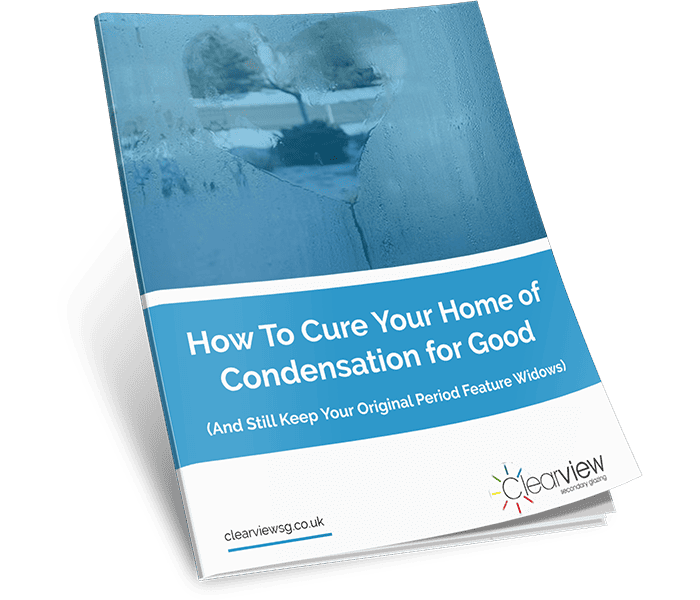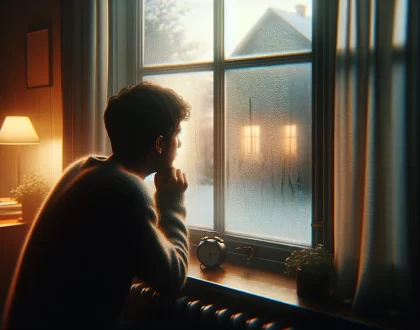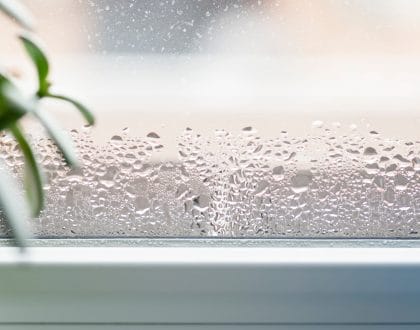How to Prevent Condensation on Windows

Winter brings a whole range of issues for your property – whether it’s maintaining a comfortable temperature, sweeping up never-ending piles of leaves or cleaning up after muddy boots. For some people, condensation is up there with these pesky winter problems.
In this post, we look at what causes condensation on windows and some ways you can remove or prevent the problem altogether.
Why do my windows get condensation?
As the weather gets colder, condensation begins to build up on the windows of properties across the UK, leaving windows looking misty from both the inside and outside. It’s more than just unsightly too. Condensation eventually rolls down off the windows leaving pools of water on your windowsill. But what causes condensation in the first place?
It comes down to two factors – temperature and humidity. Air naturally contains moisture, holding more water vapour when it’s warmer. As we heat our homes and continue to complete day-to-day tasks like showering and cooking, the air in our properties becomes more humid – holding more moisture. Here are just a few more things that can make the air more humid inside your home:
- Boiling the kettle
- Drying laundry
- Gas heaters
- Rising damp
- Breathing – yes, even the air you exhale contains moisture
While it’s held by the warm air, moisture is naturally attracted to the cold. That’s why, when you ventilate your property, the warm moist air will head out to the cold exterior. The problem occurs when your property also has cold surfaces – namely, windows.
Cold windows will attract the warm, humid air. When the humid air comes into contact with the cold surface, the water vapour condenses into a liquid, which sits on the windows. That’s what we know as condensation.
Removing or preventing condensation?
To remove or prevent condensation, you need to tackle one of those two factors – temperature or humidity. One option is ventilation, which will draw warm, moist air out of your property. Opening your windows for a few minutes each day will make a significant difference. The problem is this will also make your property colder, costing you more in energy bills to heat it back up.
A dehumidifier will remove moisture from the air without removing heat. However, it will also disrupt the look and feel of your home and use more energy. Not to mention that it needs to be emptied from time to time. The main issue here is that a dehumidifier doesn’t really tackle the problem on a permanent basis.
You could also consider permanent ventilation such as attic vents, whole house fans and ceiling fans. Exhaust fans in the bathroom and kitchen will also draw out moisture that’s created when you’re cooking, boiling the kettle, bathing or showering.
Can I prevent condensation on my windows?
The best way to prevent condensation on windows is to tackle the root cause – the cold surface. Not all windows have a cold surface, and those which do can be fixed. One common option is to have new windows installed.
So, will new windows stop condensation? In many cases, yes.
Double glazing stops condensation occurring by eliminating the cold temperature on the inside of your windows. The two panes of glass are separated by a small gap, typically around 4-20mm. This provides an important extra layer of insulation between the two panes.
So, while the exterior pane of glass will naturally become colder, the interior pane won’t become as cold. It won’t attract the humid air inside your property, and the issue of condensation will be prevented.
Common pitfalls with double glazing
That said, new windows are not necessarily the best option. As well as being costly, having new windows installed is highly disruptive for your property. It means having the full unit taken out and replaced, not to mention waiting for contractors.
When they’re in place, double glazing units sometimes develop their own condensation problems. A small break in the seal around the edge of the windows will allow moisture to enter and condense between the two panes.
It’s also stressful trying to find windows that match your property’s style, especially if you’re in a heritage building. There are further complications in a listed property, where changes to key fixtures like the windows are usually prohibited.
What about secondary glazing?
Secondary glazing is a condensation solution which doesn’t require any changes to existing windows. Instead of installing new windows with multiple panes, a secondary pane is fitted on the inside of existing windows. This creates an insulative, well-sealed gap between the two panes which prevents the temperature plummeting on interior glass.
When designed and installed with precision, secondary glazing is discreet and retains the appearance of the original windows. It’s recommended by historic England for Grade I and II listed buildings and used by the National trust along with countless other conservation areas.
Best of all, it has a range of benefits that go beyond eliminating condensation alone. Secondary glazing improves thermal insulation, reduces noise levels and increases security for your property.
DIY secondary glazing
Clearview provides high quality DIY secondary glazing to individuals and businesses across the UK. With our fully assembled, pre-drilled kits and clear installation instructions, you can install secondary glazing to your windows in no time, with zero stress or hassle.
So, you can wave goodbye to the condensation on your windows and make your home warmer in the process.

Discover How To Cure Your Home of Condensation for Good
Yes, you did read that correctly. Unlike the common cold, there is a cure for condensation. A permanent one. In this free eGuide – written by specialists – you will discover how to get rid of condensation – for good and enjoy a warm, dry home again.
Simply enter your name and email below and we will send a free copy straight to your inbox.
Recommended Posts

How can I stop condensation?
06/02/2024

Why Are My Windows Wet Every Morning?
07/01/2021

 10 Year Guarantee
10 Year Guarantee 5 Star Customer Reviews
5 Star Customer Reviews